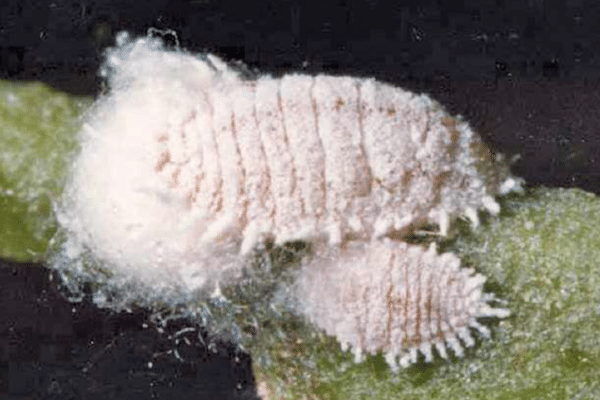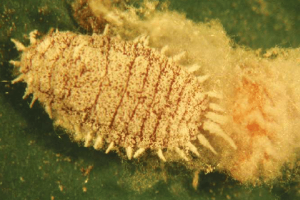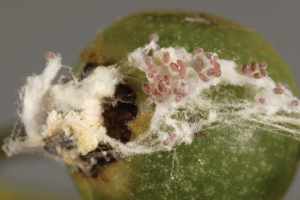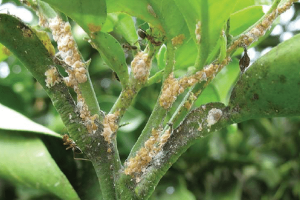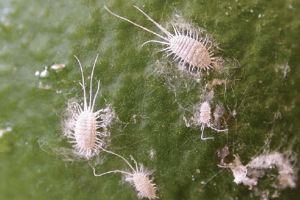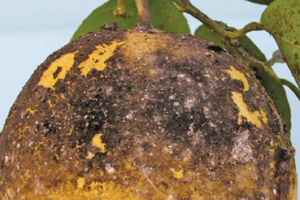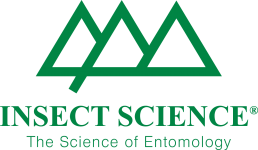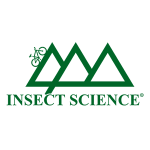Host plants
All of the species treated here are polyphagous and, apart from the citrus, feed on a wide range of indigenous and exotic trees and shrubs in various plant families, including many subtropical crops such as coffee, mango, guava, papaya, banana, macadamia, pineapple and avocado in addition to deciduous fruit such as apple, pear and grapes. Long-tailed mealybug is also a well-known pest of ornamental greenhouse and indoor plants.
Damage
Direct damage to citrus is caused by mealybugs feeding under the calyx, which results in the formations of dents and lumpy shoulders in the fruit tissue around the calyx. This type of damage can be particularly severe where the Karoo thorn mealybug is involved. In addition, fruitlets subjected to heavy mealybug infestations turn yellow and drop; infested fruit can also be malformed without dropping. Fruit damage usually occurs between petal fall and the fruit attaining approximately golf ball size.
Young leaves infested with mealybugs become characteristically bent as a result of the insects’ feeding activity at the main vein. Karoo thorn mealybug feeding on young twigs results in bulbous outgrowths and young trees may be stunted.
Furthermore, thrips scarring of the fruit around the calyx is accentuated on the fruit which harbors a mealybug infestation below the calyx. In regions with cold winters, late season mealybug infestations on the cheeks of the fruit especially naval oranges, readily lead to the formation of reddish blemishes on the peel (hyper-pigmentation or stippling). Persistence of mealybug infestations on grapefruit after end of January leads to the formation of intensely coloured bumps on the cheeks of the fruit and irregular colouring due to sooty mould. The incidence of post-harvest navel end Alternaria decay has been found to increase with mealybug infestations.
Apart from direct damage to fruit, indirect damage can be caused by the sooty mould (illustrated) that develops on the copious amounts of honeydew produced by the mealybugs.
The carob moth Ectomyelois ceratoiae (Zeller), which is sometimes a minor pest, becomes a problem in grapefruit orchards that are infested with mealybugs; the reddish larvae feed on mealybugs and honeydew beneath the calyxes, between touching fruit and especially between leaves and fruit.
Mealybugs occur sporadically in all production areas, but have historically been problematic in Swaziland, KwaZulu-Natal and the Eastern Cape. The status of these pests increased in most regions from the early to mid-1990s, attributed to the move away from broad-spectrum, full- cover spray treatments in spring, the disruption of biological control through the use of some thripicides and the regular use of some insect growth regulators (IGRs) for the control of red scale.
Some mealybugs are phytosanitary pests for many markets and their economic importance in terms of phytosanitary considerations may be quite different to their conventional pest status.
Life history
The duration of the life cycle from egg to egg depends largely on the climatic conditions. For citrus mealybug it may vary from four weeks in mid-summer to several months during winter. From 300-587 eggs are laid per female over 6-14 days. The eggs hatch in 6-10 days in summer. Each of the three nymphal stages lasts slightly over two weeks after oviposition commences about two weeks after the final moult.
The development rate of oleander mealybug on the citrus in the field is considerably slower than that of citrus mealybug, whereas in Karoo thorn mealybug it takes even longer. The developmental rate at constant temperature, of the long-tailed mealybug on butternuts, is only slightly slower than that of citrus mealybug.
Natural enemies
Mealybugs are, in general, attacked by an efficient complex of natural enemies, consisting of numerous hymenopteran parasitoids, predatory fly larvae, lacewings and ladybird beetles. If not disrupted by sprays, these insects are capable of rapidly bringing severe infestations under complete control during mid to late-season. These natural enemies are also found in the orchards in early spring, indicating that the natural control of mealybugs is also susceptible to chemical disruption from early-season sprays such as thripicides.
One of the two most abundant hymenopteran parasitoids is an undescribed encyrtid wasp, Anagyrus sp. nr. Pseudococci (Girault), which is easily recognized by its brownish colour and distinctive white antennae with which they tap the substrate whilst searching for prey. The other wasp is Coccidoxenoides perminutus Girault (Encyrtidae), which is not easily recognizable because of its small size (1 mm). Anagyrus sp. nr. Pseudococci generally parasitizes third instar and adult mealybugs., whereas C. perminutus generally attacks second instar mealybugs. Mealybugs parasitized by these species form small oblong mummies.
Ladybird beetles of the genus Nephus are common predators, but the larvae are often mistaken for mealybugs, which they closely resemble. Other coccinellid predators which can have an impact, especially on high density mealybug infestations, are Exochomus spp. and Cryptolaemus montrouzieri Mulsant, the latter particularly in the Eastern Cape.
Chrysopids (green lacewings) and hemerobiids (brown lacewings) also occasionally play an important role in controlling population outbreaks of mealybugs. The entomopathogenic fungus, Cladosporium sp. nr. oxysporum, may also suppress mealybug populations.
Management
If the natural enemy complex of mealybugs is well conserved, no additional control measures are required. In order to achieve this, effective ant control is extremely important. Even very low-level activity in the tree can be significantly disruptive. Judicious selection of chemical treatments for other pests, particularly thrips and red scale, is also important.
Augmentative release of biocontrol agents, mass reared in insectaries, has been shown to be a valuable control strategy. The coccinellid predator C. montrouzieri is effective in controlling heavy mealybug infestations, at a release intensity of 1000-2000 beetles/ha. Augmentation of the parasitoid C. perminutus has been shown to be an effective control strategy for citrus mealybug. Research trials indicate that C. perminutus should be released at a rate of 10000/ha per season, commencing in spring. Anagyrus sp. nr. pseudococci may also prove to be an effective augmentation candidate in the future. Research trials indicate that it should be released at a rate of 2500-5000/ha per season.
The most effective time for chemical suppression of mealybugs is in spring, specifically shortly after commencement of the first crawler movement. A range of organophosphates, one carbamate, a neonicotinoid and one insect growth regulator (buprofezin) are registered for control of mealybug. However, without contribution of the natural enemy complex, the timeous use of the most effective treatments presently available will not provide effective control for the season. It is therefore essential, in the management of the mealybug infestations, to avoid the use of disruptive sprays for the control of other pests. Trunk or soil treatments with neonicotinoids for red scale before bloom can provide suppression of mealybug populations.

